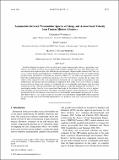Asymmetries between Wavenumber Spectra of Along- and Across-Track Velocity from Tandem Mission Altimetry
Author(s)
Wortham, Cimarron; Callies, Joern; Scharffenberg, Martin G.
DownloadWortham-2014-Asymmetries between.pdf (1.430Mb)
PUBLISHER_POLICY
Publisher Policy
Article is made available in accordance with the publisher's policy and may be subject to US copyright law. Please refer to the publisher's site for terms of use.
Terms of use
Metadata
Show full item recordAbstract
Satellite altimetry has proven to be one of the most useful oceanographic datasets, providing a continuous, near-global record of surface geostrophic currents, among other uses. One limitation of observations from a single satellite is the difficulty of estimating the full geostrophic velocity field. The 3-yr Jason-1–Ocean Topography Experiment (TOPEX)/Poseidon tandem mission, with two satellites flying parallel tracks, promised to overcome this limitation. However, the wide track separation severely limits the tandem mission’s resolution and reduces the observed velocity variance. In this paper, the effective filter imposed by the track separation is discussed and two important consequences for any application of the tandem mission velocities are explained. First, while across-track velocity is simply low-pass filtered, along-track velocity is attenuated also at wavelengths much longer than the track separation. Second, velocity wavenumber spectral slopes are artificially steepened by a factor of k[superscript −2] at wavelengths smaller than the track separation. Knowledge of the effective filter has several applications, including reconstruction of the full velocity spectrum from the heavily filtered observations. Here, the hypothesis that the tandem mission flow field is horizontally nondivergent and isotropic is tested. The effective filter is also used to predict the fraction of the eddy kinetic energy (EKE) that is captured for a given track separation. The EKE captured falls off rapidly for track separations greater than about 20 km.
Date issued
2014-10Department
Massachusetts Institute of Technology. Department of Earth, Atmospheric, and Planetary Sciences; Woods Hole Oceanographic InstitutionJournal
Journal of Physical Oceanography
Publisher
American Meteorological Society
Citation
Wortham, Cimarron, Jorn Callies, and Martin G. Scharffenberg. “Asymmetries Between Wavenumber Spectra of Along- and Across-Track Velocity from Tandem Mission Altimetry.” J. Phys. Oceanogr. 44, no. 4 (April 2014): 1151–1160. © 2014 American Meteorological Society
Version: Final published version
ISSN
0022-3670
1520-0485